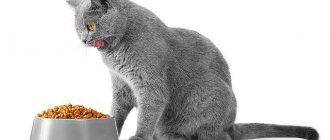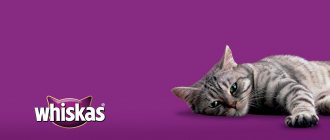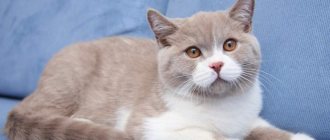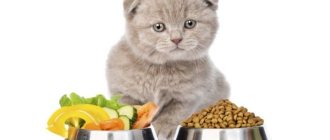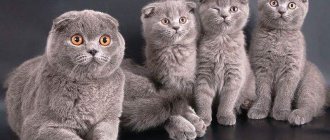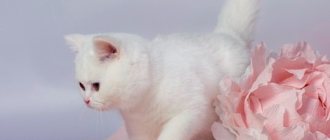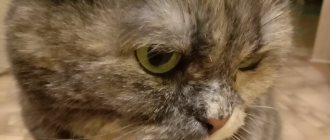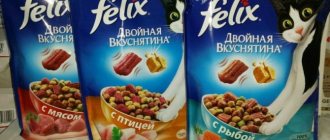British is an artificially bred breed. Not all foods that are fed to barn cats are suitable for her. The health and longevity of the pet depends on how responsibly the owner approaches the preparation of the diet. And for kittens, proper nutrition is doubly important. Therefore, when it comes to feeding, recommendations from veterinarians and experienced breeders of British cats will not hurt.
Choosing a place and utensils for feeding
A British cat should have a separate place for eating. Important terms:
- safety;
- comfort;
- privacy;
- availability.
You should not feed your Briton in a hallway where people often walk, or in a room with a TV constantly on. Extraneous noise will distract the cat.
For your information. If there is already a pet in the apartment, it is better to feed the kitten separately at first. Otherwise, the older pet may take the food away from him.
British cats are best fed from deep stainless steel or ceramic bowls. The dish should be wide enough so that the mustache does not rest against the sides. After each feeding, the bowls are washed, and the area where the cat ate is wiped with a damp cloth. You can put oilcloth or a rubber mat there - this will greatly simplify cleaning.
The first days of a kitten in the house
The new resident first needs to adapt: find out where the toilet and food are. In addition, he will look for his mother and call her loudly. New smells and new family members frighten the pet, so it will be natural for the baby to hide in a dark place.
How a kitten gets used to a new home goes like this:
- In the first days, you need to leave the kitten alone and try not to forcefully hold it in your hands if it breaks free and avoids attention. It’s better to start getting acquainted with the kitten, communicating with it in a gentle tone, then the pet can overcome fear and meet you halfway. Also, do not make loud, sharp sounds, which can greatly frighten the new tenant;
- provide the opportunity for the baby to gradually master the territory of the new home. To begin with, let the kitten stay in one closed room for several days, where there will be bowls of water, food and a tray. However, the toilet and food should not be located close together; try to place them far away from each other, but not so that the baby cannot find them. After a few days, when the kitten gets used to it, you can let your pet explore other rooms;
It is necessary to get acquainted with the new tenant gradually, without making loud sounds or making sudden movements
- Usually three-month-old kittens have already been trained by a cat to go to the litter box, but stress and new smells can confuse the baby. Therefore, be patient and be vigilant, as soon as the kitten wants to go to the toilet, immediately move it to a new tray and after all the work, do not wash it for a while so that the kitten can recognize the toilet by the smell. It is best to take a little litter from the tray where the kitten went with its mother, this will make getting used to the new toilet easier;
- Feeding your baby should not change dramatically. Ask the breeder what the kitten ate before moving and at first strictly feed the pet the same diet. The change of food should be smooth: you need to gradually mix the new food with the usual one, otherwise the gastrointestinal tract of a small pet may be disrupted.
In a house where there is a kitten there must be a scratching post
Natural diet
Many owners prefer to feed their British cat natural food at home. It is believed that this is the most physiological type of nutrition. Cats are carnivores by nature, so their diet must include meat and other products that are available to animals in the wild.
What foods should be given?
The basis of the diet (60-70%) of British shorthair and longhair cats is made up of lean meats - beef, chicken, turkey. Lamb, pork, geese and duck meat are too fatty, so they should not be fed to pets.
About 2 times a week the menu includes offal:
- boiled liver;
- heart;
- kidneys;
- lungs;
- language;
- chicken stomachs.
They provide the body with amino acids and add variety to the daily menu.
Another important component of the diet (25-30%) is vegetables, fruits and herbs. These are sources of vitamins, minerals and dietary fiber.
It is useful to feed British cats:
- carrots;
- cucumbers;
- asparagus;
- pumpkin;
- zucchini;
- apples;
- apricots;
- sprouted oats;
- lettuce leaves;
- dill
Vegetables and herbs are given in the form of salads or mixed into meat. Fruits can act as treats.
Once every 3-4 days, British cats are fed boiled sea fish. It must be cleaned of bones and scales.
At home, British cats are also fed fermented milk products: low-fat kefir, cottage cheese, curdled milk, natural yogurt. Once a week they pamper you with grated cheese.
Important. Only kittens can be given milk. It is usually not absorbed by adult cats.
To provide your pet with additional energy, the menu includes rice and buckwheat porridge. They account for 5-10% of the total food volume.
British cats are fed chicken or quail eggs 2-3 times a week. These products do not need to be boiled if the owner is sure that they are not contaminated with pathogenic bacteria.
It is preferable to use only the yolk. It is given separately or mixed with fermented milk products.
For your information. If you feed your British cat correctly, she will have a shiny coat, clear skin and clear eyes.
Rules and regulations for preparing natural food
If you feed a British cat natural food, you should adhere to the following rules:
- British cats are fed only fresh food. You can freeze a few portions for an emergency, but you can’t use this method all the time.
- Meat can be given raw, but first it must be scalded with boiling water or frozen for 2-3 days. This is necessary to destroy parasites.
- The British are fed thick food at room temperature. If the food was in the refrigerator, it must be reheated.
- Vegetables, meat and fish are not mixed with fermented milk products.
- Meat is given along with vegetables and herbs.
The daily feeding rate for British breed cats is about 5% of their weight, or 40-60 g of food per 1 kg of weight. The serving size is adjusted according to the age, activity level and individual characteristics of the animal.
Important. British cats are prone to obesity - they should not be overfed.
In what form should the food be given?
A cat needs food to be served either in small pieces or in large pieces from which smaller pieces need to be torn off. Minced meats and pates are not suitable for healthy cats: the absorption of nutrients from them is lower. And it’s not in the nature of a predator to eat formulas similar to those for children.
When preparing meat for serving, even before freezing, it is either divided into large pieces, or mixes of different components cut into smaller pieces are prepared - muscle meat, offal, vegetables if necessary, etc. The required amount of meat (for 1-2 servings) is placed in a bag or plastic container and sent to the freezer for at least 3 days.
If you give your cat large pieces of meat, then one serving may contain only 1-2 types of meat with the addition of, for example, a piece of liver. And then the types of meat alternate. Moreover, it is not necessary to alternate every day: you can feed one type of meat for a week, and then change it. At the same time, of course, we do not forget about calcium and fatty acids, which must enter the body either in the form of food or with dietary supplements.
Mixes can be a complete diet for a longer period, if everything necessary is taken into account. Some people add meat, bones, organs, vegetables, and even eggs to them at once. And then you just need to defrost it, wait until the temperature reaches room temperature, and serve it to the cat.
Ready-made feed
Many owners prefer to give their Britons dry food and wet canned food - it’s convenient and simple. But the products must be of high quality - not lower than premium.
It is better to avoid buying cheap food from the nearest supermarket. Economy class food contains practically no natural meat. But they contain ballast substances, dyes, flavors and other harmful components.
You should carefully study the composition of the feed. Meat should come first. Good products contain vitamins, minerals and amino acids that support the health and strengthen the immune system of the British cat. A minimum of carbohydrates is encouraged - they lead to weight gain.
Selection of industrial feed
Owners of British cats consider the following brands to be the best food:
- Earthborn Holistic;
- Go! Natural Holistic;
- Bosch Sanabelle Grande;
- Acana;
- Orijen;
- Eukanuba;
- Eagle Pac Cat Holistic;
- 1st Choice.
This is a super premium class and holistic food. They are quite expensive, but their composition fully satisfies the needs of the cat's body.
If your budget is limited, you can purchase premium food for the British:
- Purina Pro Plan;
- Brit Premium;
- RoyalCanin;
- Hill's.
The Royal Canin company produces a special food for British kittens that can be fed to babies aged 4 to 12 months - British Shorthair Kitten. It is highly digestible and contains prebiotics that support the functioning of the gastrointestinal tract.
Royal Canin produces British Shorthair Adult food for adult cats. It helps Britons maintain muscle mass. Omega-3 fatty acids strengthen joints and maintain their mobility.
For kittens, pregnant, lactating, spayed, neutered, elderly cats or pets with any diseases, buy food from specialized lines. All well-known manufacturers have such names.
Before choosing food for your British cat, it is better to consult a veterinarian. He will give individual nutritional recommendations.
What is the best food for British cats?
When answering the question of which food is most suitable for a British cat, one cannot fail to mention once again well-balanced natural feeding. Read about the evidence of its exceptional benefits. If you still decide to stick to industrial food, then read on in this article.
Article continues after advertisement
Feeding cats commercial food is suitable for people who:
- do not have time to prepare food for the cat: this requires approximately 2-3 hours a month;
- for some reason cannot deal with raw meat;
- unable to understand the peculiarities of natural feeding: there are people who cannot remember even the most basic information - it is better for them to buy ready-made food so as not to harm the animal;
- have a lot of money to buy quality food: good industrial food is expensive.
Feed can be wet or dry (dehydrated). Wet food is healthier than dry food because... It is important for cats to get plenty of fluids with their food. This is a prevention of urolithiasis, urinary tract infections, damage to the mucous membranes of the gastrointestinal tract and other problems. However, good wet food is more expensive, so consumers often choose dry food, not understanding why they should “overpay for water.” They are wrong, but we’ll talk about that later, but for now let’s talk about feed classes.
All food is divided into 4 classes, but the editors of the Murkotiki website also distinguishes a fifth class.
- Economy class. This is everything that is sold in supermarkets: Whiskas, Kitekat, 4 Paws, Felix, Friskies, etc. The composition of such feeds often does not indicate the percentage of ingredients and their origin. You can see, for example, the column “poultry meat”, but you cannot know what kind of bird it is: a crow killed on the road or a domestic chicken. Consumption of such feed has serious health consequences.
- Premium class. This is food that is a little better than economy class, and can be found on the shelves of supermarkets and veterinary clinics. This class includes Brit, Royal Canin, Trainer, Eukanuba, Monge, Nutra Mix, Pro Plan, etc. A sign of a premium class is that the composition contains a large amount of carbohydrates (mainly from cereals), meat of unknown origin (the type of meat is not specified) or “animal protein” without specifying details, the percentage of ingredients is often not indicated. There are other disadvantages as well.
- Super premium is slightly better than premium, however, some premium foods are better than some super premium foods. Below we will explain why this happens. Super-premium foods include 1st Choice, Leonardo, Brit Care, Pronature Life, Sanabelle, etc.
- Holistic . Marketers position these foods as specialized nutrition for solving certain health problems and sometimes even behavioral problems. For example, you can find food for a sterilized British cat, hypoallergenic food, food for cats with skin problems, for cystitis, after gastrointestinal infections, and others. In fact, holistic treatments do not always have a healing effect. And, according to the observations of the Murkotiki website, there are foods that say “holistic” on the packaging, but which actually harm and do not heal. Therefore, the fact that the package contains the addition “holistic” does not mean anything.
- Elite class . The Murkotiki website highlights this class separately. Most of the food in our rating can be attributed to this category. Such food cannot be found on supermarket shelves, but can be purchased in specialized online stores. They are expensive - more expensive than the meat from which they are made. The composition includes a large number of animal products, and the method of preparation is not carcinogenic high-temperature extrusion, but drying or processing at lower temperatures. The elite level requires 80% meat in the composition (ideally 90%), meat is always of known origin, not “horns and hooves” are used, but tenderloin and high-quality offal. The elite food included in the rating does not contain grains, legumes or potatoes.
The reader should understand that the division into classes is arbitrary. There is not a single official document regulating the specific criteria that food of a particular class must meet. Manufacturers themselves choose what to write on the packaging. Often, premium or holistic is no different from economy.
Moreover, low-quality food is sometimes prescribed to patients by veterinarians - and this only aggravates the problem. The editors of the Murkotiki website are often contacted by cat owners who have suffered from veterinarians’ recommendations regarding the choice of food. This, by the way, happens not only because of the illiteracy of doctors, but also because of their commercial interest in selling a particular brand. It has long been no secret that the owners of veterinary clinics enter into contracts with feed manufacturers and set sales plans for their subordinates.
EXPERTS' COMMENT: ADMINISTRATION OF THE ONLINE PET SUPPLIES STORE LAPA.SHOP
“The myth that high protein diets are bad for cats' kidneys is the result of marketing from poor quality food manufacturers. Diets high in plant proteins are hard on carnivore organs, while diets high in animal protein are not only beneficial, but necessary. Low quality pet food is loaded with protein from soy, corn, and other foods that are unhealthy for cats. This allows the manufacturer to increase the protein content of the food without actually offering the pets any protein they can digest. And veterinarians, with their illiterate statements about excess protein, are only trying to justify the sale by themselves of low-quality products of industrial giants. Big brand foods sold in veterinarians' offices may be marketed as premium, but just looking at the ingredients says otherwise. Formulas may contain several specialized ingredients to market themselves as a special diet, but in reality, they are no different from regular ones. And the education of a veterinarian does not include in-depth study of such disciplines as dietetics and small animal nutrition. Therefore, in the person of a veterinarian, you most often find nothing more than another seller of low-quality products.”
Mixed feeding
Breeders and felinologists do not recommend feeding the British cats both natural food and industrial food. This is fraught with problems with digestion and urination. In addition, it will be difficult for an inexperienced owner to balance the diet and calculate its calorie content.
Sometimes a British cat can still be given different types of food, but this needs to be done at different feedings. For example, offer your pet dry kibble in the morning and meat in the evening. But it is not recommended to practice this method constantly.
Feeding frequency from birth to one year
From birth to 5 weeks
IMPORTANT: even at such a young age, the breeder already adheres to some type of nutrition. Babies cannot be given ready-made food for an afternoon snack one day, and something in its natural form the next day.
If the cat does not have milk, or she died in childbirth, and it was not possible to find a nurse, then British kittens, like all orphaned cats, are fed from special drinking bowls with goat's milk, or a special mixture in small portions 5-6 times a day. At the same time, kittens should not be given infant formula; they are too high in calories and oversaturated with sugar for cats.
From 5 to 9 weeks
The kittens still eat in small portions, 5 times a day, at least. The cat gradually stops natural feeding. Kittens, in turn, are actively growing and need complementary feeding as an inevitable and necessary source of calories and nutrients.
It is good to feed two-month-old kittens in the late afternoon, for example, by replacing the fourth feeding from the cat with complementary foods.
From 10 weeks to six months
From 2 to 6 months, kittens are completely weaned from the cat. They eat on their own 4-3 times a day. At 2-3 months it is better to feed 4 times. At 3-4 months, one of the daily doses is made smaller in volume. From 4-5 months they switch to 3 meals a day. At 6 months, the kitten should already be able to eat 3 times calmly, without asking for more.
IMPORTANT: Portion size is very important to follow. A kitten up to a year old is fed 30-35 grams at a time; the total weight of food per day should not exceed 130 grams
At this stage of maturation, British kittens need to be switched from pureed food to finely chopped food. It is better to refuse dry food in favor of canned wet food.
From 6 to 12 months
During this time period, the kitten is transferred to 2 meals a day, increasing the amount of food per day to 250 grams. Also during this period, the owner of the British cat must finally decide on the type of food and consult with a veterinarian on the selection of a vitamin complex to improve the balance of the selected menu.
Algorithm for switching to a different diet
A British cat cannot be suddenly switched from dry food to natural food, and vice versa. Sudden changes in diet disrupt the functioning of the digestive system.
New food is introduced gradually over 10-14 days. First, 25-30% of the usual food is replaced, and the rest of the food is left the same.
After 2-3 days, the proportion of unfamiliar food is increased by another 10-15%. This is done until the British cat completely switches to the new diet.
During the process, the condition of the animal is closely monitored. If allergies, indigestion or other negative reactions appear, return to the usual menu. In such situations, the cat is taken to the veterinarian so that a specialist can help choose the appropriate diet.
Often British people refuse to eat natural food after ready-made food. In this case, you can give your cat a fasting day. Most likely, when she gets hungry, she will eat whatever her owner offers.
How to feed a cat when it is sick
The British, although known for their excellent health, have their Achilles heel. Even a few. These are their signature ailments that can be combated with a well-designed diet:
- If you have urolithiasis, you should consider reducing the composition of minerals. Pets who eat dry food often fall into the mineral risk zone. The food was probably chosen incorrectly. Therefore, it is imperative to ensure that there is no such harmful component in the composition. There must be clean, fresh water in the bowl - without this, you can forget about ridding your cat of kidney stones.
- With hypertrophic cardiomyopathy, it is advisable to take a closer look at the amount of salt absorbed by your pet. The less salt the better for the fluffy core. Previously, there was an opinion that such animals should consume less protein. This point of view can hardly be called correct, since as a result the animal lost a lot of muscle mass. As a result, they lived fewer years than they could have.
The British cat is extremely prone to obesity. We can say that she is the Achilles heel of furry companions. But well-chosen food will help avoid such troubles. Like many others.
Previous British catsDiseases in British cats and kittens - symptoms and solutions Next British catsCare and maintenance of the British cat breed
Vitamins and mineral supplements
If a British cat is fed natural products, vitamin and mineral complexes must be included in the diet. Many owners use natural supplements:
- Brewer's yeast;
- bone meal;
- fish fat.
The dosage appropriate for a particular pet is determined by the veterinarian.
A couple of times a year, it is beneficial for British cats to drink complex industrial supplements. They are used in courses of 1-3 months. Continuous use is fraught with health problems.
The following brands of vitamins have proven themselves to be effective:
- 8 in 1;
- Kitzyme;
- Gimpet;
- Omega Neo;
- Sanal;
- Veda Biorhythm;
- Canina.
There are also drugs on sale to eliminate problems with hair, internal organs, etc.
Should vitamins be added to the British diet?
Vitamins, interval complexes and other biological supplements must be included in the diet of a cat that is on a natural diet. Conventional products do not contain enough useful elements, so compensation is required. The need for vitamins in the British also increases during the growth period (from 3 to 6 months), during pregnancy and lactation, after surgery or a serious illness. Cats of this breed most often lack vitamin B, so it is necessary to purchase medications that contain it.
Useful vitamins for British cats:
- Vitamins Kitzim. They are made in the UK, contain magnesium, calcium, phosphorus, iron, taurine, B vitamins. Can be used for kittens, pregnant and lactating cats, and adult animals.
- Beaphar. This is a food supplement with biotin and taurine for adult cats produced in Holland. Contains B vitamins, as a result of which it has a positive effect on the animal’s fur, preventing its loss.
- Canina. These vitamins are produced in Germany and contain biotin, phosphorus, calcium and fiber, vitamins B12 and A. They are used in adult and elderly cats and kittens to prevent skin problems.
- Omega Neo is a domestic product. The tablets contain essential fatty acids omega-3, omega-6, vitamins A, B, E, taurine. Used to improve the functioning of the gastrointestinal tract and prevent joint diseases in adult cats.
- Veda Biorhythm - Russian vitamins developed specifically for kittens. They are used during the growth period as they improve the absorption of nutrients. Veda Biorhythm contains B vitamins, L-carnitine, taurine.
Do not forget that in most cases, vitamin and mineral complexes are taken in a course of 1–3 months. This allows you to create a depot of active components in the cat’s body. Longer use may lead to undesirable consequences. One of my colleagues, who got a British cat, purchased several different vitamin supplements at once on the advice of a veterinarian. She regularly added them to her pet’s food for six months
Gradually, the owner noticed a change in the pet’s appearance and behavior. He became more inhibited and aggressive, his fur looked unkempt
The woman took the cat to a veterinary clinic, where doctors diagnosed hypervitaminosis due to the abuse of biological additives. After stopping the pills, the animal immediately began to feel better.
Water in the diet
British cats should always have access to clean water. It is renewed 1-2 times a day - aristocratic Englishmen often refuse to drink stale liquid.
Water is especially necessary if the cat is fed dry kibble. They are dehydrated, so the pet drinks 2-3 times more than when eating natural food.
It is not recommended to give tap water to animals. It contains chlorine and other harmful impurities. Therefore, it is pre-filtered and settled. Some owners buy bottled water. Naturally, without gas.
Important. If a British cat drinks little, she may develop urolithiasis. This pathology especially often appears after castration.
Dry and wet food for the British
A more simplified method of feeding a British cat is based on ready-made food. This option is great for owners who are unable to regularly prepare healthy food for their pets. The main thing is to choose the right food and calculate the daily intake in accordance with the age of the kitten.
Responsible manufacturers create high-quality products that contain all the vitamin and mineral complexes necessary for the British. The range of such products includes a wide variety of compositions in dry and canned forms. When choosing, be sure to study the manufacturer’s recommendations published on the packaging!
Which food to choose, dry or wet, is up to you! You can combine these two types in an approximate ratio of 50/50, 60/40 or 70/30%. If the British cat is fed exclusively dry food, it is necessary to provide the animal with free access to clean drinking water.
The canned product is placed in a clean bowl in strictly measured quantities for one feeding. It is unacceptable to leave food “for later”; after each feeding, the animal’s bowl is cleared of product residues and thoroughly washed with clean water.
Advice from experienced breeders:
- For favorable growth and development, combine dry food with wet food. It is better to serve canned products for breakfast and dinner, and during the day you can feed your pet with dry food.
- Even if you feed your cat exclusively prepared food, regularly add pieces of fresh meat to the standard diet.
- The best food for a purebred British dog is premium (for example, Whiskas, Hills). Do not buy the budget version of the product, as these formulations do not contain enough necessary elements for proper growth and development. After feeding with cheap food, complications in terms of physical health are often observed. If you consume low-quality products, your kitten may develop urolithiasis and other chronic ailments.
- If you plan to castrate a mature British cat, buy special food with the appropriate label. These products contain a balanced complex of essential microelements, taking into account hormonal changes in the animal’s body. Similar rules are followed for cats that have been sterilized.
What to feed a British kitten
For the first month after birth, a Briton feeds exclusively on mother's milk. It provides babies with all the necessary substances and promotes the formation of strong immunity.
If there is no mother, British kittens should be fed with cat milk substitutes, which are sold in veterinary pharmacies. It is not recommended to give baby food. It is designed for people, not animals.
A one-month-old kitten begins to be fed breast milk in the intervals between meals. The baby is carefully introduced to solid food so that at 2-3 months he is ready to move to a new home.
For your information. The British Fold kitten, which is usually a mix with the Scottish Fold, is fed the same as a straight-eared kitten.
An approximate feeding schedule for a British kitten by age is presented in the table.
| Age | Number of feedings per day | Diet |
| British kittens: 1 month | 3-5 | · small pieces of beef; · porridge with milk; milk for kittens |
| British kitten: 2 months | 6-8 | · small pieces of beef; · low-fat cottage cheese; · porridge with milk; milk for kittens |
| British kitten: 3 months | 6 | from three months, chicken, vegetables and egg yolk are introduced into the diet, and milk for kittens is replaced with goat or cow milk; other products remain unchanged: pieces of beef; · porridge with milk; · low-fat cottage cheese |
| British kitten: 4-6 months | 5 | A British kitten at 4 months is gradually weaned off whole milk and switched to fermented milk products, the diet is enriched with: · offal; · boiled sea fish; · fruits |
| British kitten: 6-10 months | 3-4 | · all types of lean meat; by-products; · porridge; · vegetables, fruits, herbs; · dairy products; · eggs; boiled sea fish |
From 10-12 months, British kittens are fed twice a day. Now they eat the same foods as adult cats.
An alternative option is to use ready-made feed. Canned food and dry granules can be given to a small kitten of two months. The “drying” is soaked in water or milk so that the baby can chew it.
Gradually increase the proportion of dry food in the diet and reduce the amount of wet food:
- British: 3 months – 90% wet/10% dry;
- British: 4-6 months – 70-80% wet / 20-30% dry;
- British: 6-10 months – 60-70% wet / 30-40% dry;
- British: 10-12 months – 50-60% wet / 40-50% dry.
From the age of one year, the pet is given 30% wet food and 70% dry food. It is desirable that the products are from the same manufacturer. This minimizes the risk of digestive problems and allergic reactions.
The daily feeding rate for a British kitten is about 10% of its weight. When feeding dry food, follow the manufacturer's recommendations.
For spayed and neutered
Royal Canin Male for the prevention of urolithiasis
pros
- Good coat condition
- No side effects
- Disease Prevention
Minuses
High price
From 313 RUR
Dry food for castrated British cats from 1 year to 6 years. The product prevents the occurrence of urolithiasis and obesity. Veterinarians advise owners to feed their pets with food from this series after operations related to sterilization. Based on nutrition, problems of the gastrointestinal tract are solved: cats with sensitive stomachs stop regurgitating. An excellent option for cats after castration; in most cases, urolithiasis does not develop.
Bozita for the prevention of urolithiasis, with chicken
pros
- Affordable price
- Increased fiber content
- Contains fresh meat
- Practical packaging
- The packaging does not allow the smell to dissipate
- Suitable for older cats
- Contains a natural immunostimulant
Minuses
Not found
From 358 ₽
The product is suitable for indoor and adult cats from 1 to 6 years of age. The food is selected taking into account the age characteristics of sterilized and elderly cats. Chicken meat in the diet is easily digestible, L-Carnitine normalizes the metabolism of sedentary animals. The dry product boosts the cat's immunity.
TRAINER Natural Adult cat Sterilized White Fresh Meats dry (0.3 kg)
pros
- Rich composition
- Animal care
- Shiny wool
- Contains flaxseed
- Calms the animal
Minuses
Expensive product
From 333 ₽
Premium quality food combines two types of meat, chicken, turkey and fish (salmon powder). Suitable for use by all types of breeds. Mint extract relaxes your pet. The vitamins and minerals in the complex will provide the necessary elements to maintain health.
Feeding an older cat
With age, British cats become less active, and metabolic processes in their bodies slow down. To prevent them from gaining weight, the caloric content of their diet is reduced.
The British cat is fed small meals 3-4 times a day so as not to overload the digestive system.
To improve intestinal function, some meat is replaced with vegetables. They contain fiber, which stimulates the gastrointestinal tract.
You need to carefully ensure that your pet consumes enough fluid. Many owners install drinking fountains. It has been noticed that cats drink from them more willingly.
When fed commercial food, an aging pet is switched to products from lines for older cats. If dental problems appear, the cat is given more canned food and pates, which are easier to chew.
If any illness occurs, veterinarians prescribe a special diet for the British.
How to feed a cat when it is sick
The British, although known for their excellent health, have their Achilles heel. Even a few. These are their signature ailments that can be combated with a well-designed diet:
- If you have urolithiasis, you should consider reducing the composition of minerals. Pets who eat dry food often fall into the mineral risk zone. The food was probably chosen incorrectly. Therefore, it is imperative to ensure that there is no such harmful component in the composition. There must be clean, fresh water in the bowl - without this, you can forget about ridding your cat of kidney stones.
- With hypertrophic cardiomyopathy, it is advisable to take a closer look at the amount of salt absorbed by your pet. The less salt the better for the fluffy core. Previously, there was an opinion that such animals should consume less protein. This point of view can hardly be called correct, since as a result the animal lost a lot of muscle mass. As a result, they lived fewer years than they could have.
The British cat is extremely prone to obesity. We can say that she is the Achilles heel of furry companions. But well-chosen food will help avoid such troubles. Like many others.
Prohibited Products
Most foods that people eat are not suitable for cats. The British should not be fed any salty, sweet, fried, fatty, smoked, or spicy foods. The cat's body is not adapted to digest such food, and the liver cannot cope with large amounts of toxic substances.
Also, the food of British cats should not include the following foods:
- River fish;
- tubular bones;
- sausages;
- semi-finished products, canned food and fast food;
- mayonnaise, ketchup and other sauces;
- chocolate, cocoa;
- eggplants, potatoes, legumes;
- mushrooms;
- citrus fruits, grapes, raisins;
- rhubarb, sorrel, onion, garlic;
- foods and drinks that contain alcohol, caffeine and other stimulants.
A British cat should not be fed food from the human table, even if it plaintively begs for a tidbit. Such handouts will result in serious health problems.
Can I feed them regular food?
It cannot be said that the definition of “ordinary food” is appropriate for the diet of British kittens. But home-cooked food is quite appropriate in their diet. You just need to approach the process of preparing it correctly. For example, you won’t be able to do without meat, because cats are carnivores by nature.
Beef
It is administered already in the first month of life, in the form of scraped meat fibers. You can also use minced meat without any additives. The meat is pre-frozen for at least three days, then thawed and doused with boiling water to destroy bacterial flora. Both fresh and chopped beef must be given without any additives; salt, spices, and onions in any quantities are excluded. As the pet grows, the meat is given cut into small pieces.
By-products
From the third month of life, the little Briton is ready to absorb offal. Boiled beef liver is introduced weekly as complementary food, and chopped offal (heart and other liver) is also mixed into the main food 3-4 times a week. One serving should not exceed 100 g.
Fish
Only sea fish is suitable, preferably in fillet form - without extra bones. Serve it raw or boiled to the kitten.
It is important to properly pre-treat the product. Freeze it for 3 days, and then pour boiling water over it to destroy helminth eggs.
Eggs
Egg yolk is a valuable source of vitamin D, which protects the baby’s bones from deformation, the development of rickets and other possible health problems. It is mixed into porridge and other dishes, after being crushed. The frequency of introduction into the diet is 1 time per week.
Porridge
The main source of nutrition for a kitten in the first months of life is food that does not require significant effort in absorption, but is nutritious and satisfying. This category includes all porridges, which are cooked differently at each age. For up to three months, food is cooked in milk with the addition of water, sugar is completely excluded. From the age of six months, the dish is given 3-4 times a week. They cook completely dairy-free rice, oatmeal, and semolina cereals.
Vegetables
An obligatory component of a British child's diet is boiled vegetables rich in fiber. Children are given carrots and cauliflower, chopping the ingredients and flavoring them with a small amount of vegetable oil. You can add prepared vegetables to the main meat dish or porridge.
Dairy products
The source of calcium in the kitten’s diet 3-4 times a week is fermented milk products - natural yoghurts without sugar or additives, cream, cottage cheese, kefir. You should choose a product with a low fat content.


